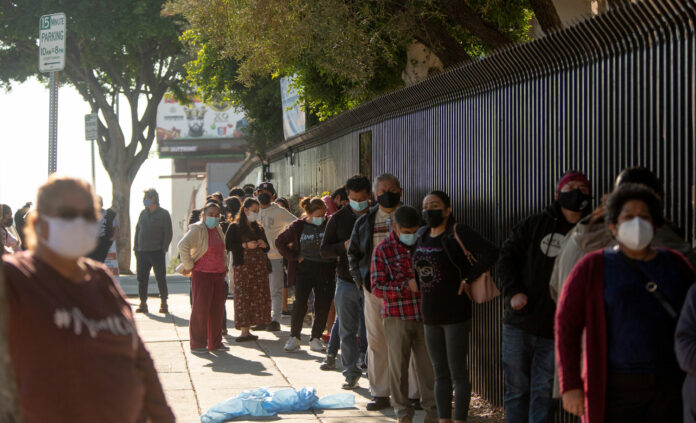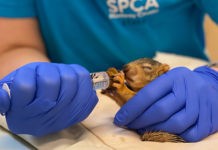
(California Today)
How fast is the coronavirus spreading in California?
1. A considerable spike in new cases over the holiday weekend — nearly a quarter million — was reported by the state health department Tuesday, with an average of nearly 59,000 cases a day recorded from New Year’s Eve through Monday. The rate of new cases has soared to 134 per 100,000 residents and is poised to obliterate the peak set last winter.
2. Transmission has set a record, blowing even past the heights of 2020, the California Department of Public Health reported Tuesday. State computer models show the virus moving so quickly in Los Angeles County that roughly two people are being infected by every carrier.
3. Test positivity has shot up by 1,000% in a month. More than 20% of coronavirus tests have come back positive over the past week in California, according to the statewide average. At the start of last month, the seven-day average test positivity rate was a little over 2%.
Why so swift? The omicron variant, mostly. But also holiday gatherings. The variant appears to produce less severe cases, but its spread is particularly bad timing as schools reopen after the winter break.
Alex Cherniss, the superintendent of the Palos Verdes Peninsula Unified School District, where about 10,000 students in coastal Los Angeles County returned to classrooms this week, told me Tuesday that school attendance dropped by about 10% Monday as testing of students and staff detected about 170 coronavirus infections.
About 70 were among children who had already come back to campus, he said, and each had secondary contacts who also had to be sent home. Earlier in the academic year, he said, perhaps 3% of students would have returned from a break with an infection. A county health official, he said, told him to assume that a tenth of his student body had the virus — roughly 1,000 children.
As Dr. Bob Wachter, chair of the department of medicine at the University of California, San Francisco, put it in a New Year’s Eve tweet: “Be super careful — it’s raining COVID.” And yet in an interview this week, Wachter also was bullish on California’s prospects. Here’s some of our chat, edited and condensed:
Q: Are things as bad as they look?
A: We’ve got a pretty terrible period ahead of us. The question is how long it lasts, and how bad it gets. We now have pretty good evidence that omicron is a substantially less severe virus than delta, particularly in people who’ve been vaccinated. And we’re seeing a disconnect between the number of cases, which are enormous, and the numbers of hospitalizations and people in intensive care units who are really sick.
Q: So there’s hope?
A: I think February and March are going to be OK, and maybe even very good. The way omicron is acting, the levels of immunity, the fact that many unvaccinated people are going to get their immunity the hard way, through infection — there’s much that is hopeful over the next four to six weeks.
Q: Should schools be open?
A: If we take all the precautions — ventilation, opening windows, testing, people upping their mask game — and the kids are vaccinated, there’s a reasonable chance we can operate the schools safely. But it’s probably not going to work where all that is not happening. There’s this narrative that closing the schools was the biggest mistake of 2020, which I think kind of hardens everybody’s position. Closing presents real hardships to kids and their parents. We also are looking at a really very large threat in terms of infection that probably will be gone by February. There’s so much infection around now that there’s a good chance someone will have COVID in a classroom of 20 kids.
Q: Are California’s pandemic policies working?
A: California was always doing better than Texas and Florida in per capita deaths, but today the per capita death rate in Texas is about 35% higher than California’s. In Florida, it’s 50% higher. Those are massive differences. If Texas and Florida had California’s per capita death rate, they would each have 20,000 more people alive today. Forty thousand lives saved. To me, that’s nontrivial.
This article originally appeared in The New York Times.
Copyright 2022 The New York Times Company














